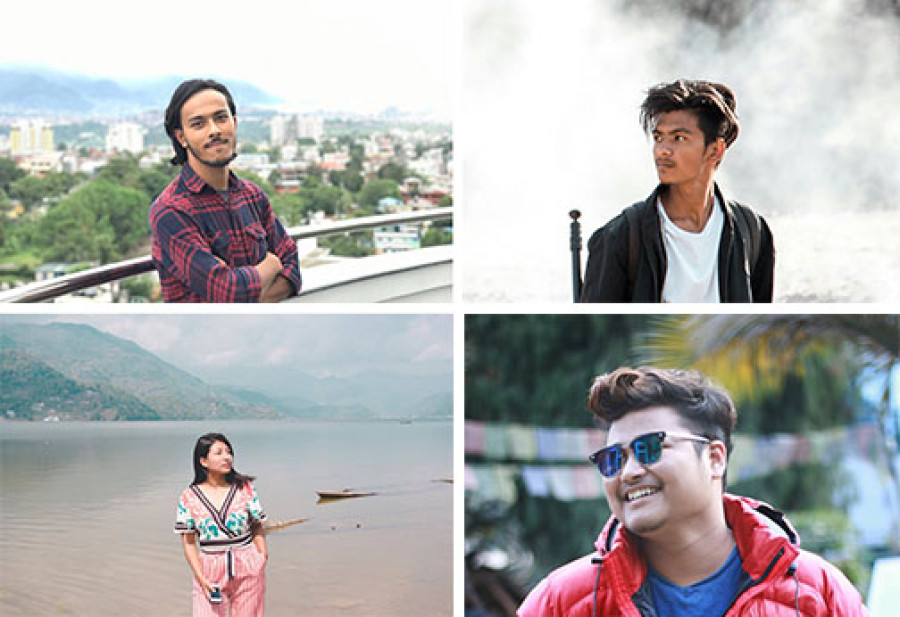Culture & Lifestyle
How young videographers are breaking the mould
With the rise of social media and increase in demand for sleek online videos, young people are taking videography as a full-time profession.
June Karkee
Nishon Shakya wasn’t doing very well in school. While his peers were focused on their academics and had aspirations to pursue traditional career paths, Shakya was less drawn towards his schoolwork and more on his hobby: photography.
Now 21 year old, Shakya has been pursuing videography for the last six years, having worked on many personal as well as commercial projects. Recently, he was the director of photography for the Nepali short film Hide, and is working with Miss Nepal Earth 2019 Riya Basnet for her Miss Earth 2019 ‘Eco video’.
With the rise of social media platforms, many young videographers have emerged in recent years, mostly working on commercial short videos like advertisements for different brands, portfolio videos for celebrities and music videos. Apart from that, videographers are also high on demand during wedding seasons—with the majority of clients preferring high production creative videos. Due to these diverse avenues, many young videographers, mostly in their early 20s, have embraced videography as a full-time profession, which they say has abundant opportunities but is an equally challenging pursuit.
Twenty-one year old Aaditya Shrestha has a very similar story to that of Shakya. He was already pursuing an engineering degree when he decided to drop out of college and pursue videography as a profession.
“I studied engineering because my parents believed it would help me be financially stable in the future, but I had no interest in it,” says Shrestha. “Videography, on the other hand, was something I was passionate about.”
But pursuing videography isn’t just about passion or skill-set—it demands a certain investment like any other business enterprise. To take up videography as a profession, one needs to be equipped with the latest gears and equipment, which can be extremely expensive.
Shrestha had to request his father to lend him money to purchase his first camera. “My dad took a loan of Rs345,000 to help me. The camera then had to be ordered from the US because it costs even more in Nepal,” he says. “But this is necessary because, without the right equipment, it is difficult to be a professional.”
For both Shakya and Shrestha, however, it was worth the risk. They refused to follow conventional academic and career paths expected of young people in Nepali society, and videography has not only become a medium to express their creativity but to earn a decent living.
“If you are good at what you create, the clients are ready to pay a decent amount,” says Shakya. “There’s also fun, creativity, the process of learning, getting to meet new people, and thankfully because the demand for such creators is increasing in Nepal, videographers are also paid a decent amount of money.”
According to Shrestha, a skilled videographer can expect to have a monthly income of at least Rs15,000-20,000, depending on a videographer’s portfolio, creativity, skill-set and seasonal demands.
But talent and experience alone aren’t enough to guarantee success to artists and creators in Nepal, say some of the young videographers, who say that clients tend to discredit their credibility on the basis of their age and gender.
“I am usually not trusted to handle project budget. But I think age shouldn’t matter, it’s the hard work that should count,” says Diwash Paudel, a 19 year old videographer.
For 22 year old Neesha Khaling, who initially began videography as a hobby, being a female in a male-dominated profession can, at times, be a little intimidating.
“Some people underestimate me because they have the mindset that only men can create good videos,” she says. “I feel like there’s still a long way for us women to be equally numbered as men in this industry, but I believe that we will get there.”
Apart from age and gender issues, one common struggle these young videographers have been facing is the lack of academic education and mentorship from industry veterans. As much as they are reliant on social media platforms like YouTube for disseminating their videos, they learn different techniques of videography through the same platform.
“I was hugely inspired by American filmmaker and vlogger Casey Neistat to take up videography professionally,” says Shrestha.
Abin Bho, a 20 year old filmmaker who gained massive popularity after directing Shrinkhala Khatiwada’s Miss Nepal World introduction video, which went viral last year, says that lack of mentors has been the biggest pushback for him.“We have to teach ourselves by watching tutorials on the internet,” he says. “This can be a good thing, as it encourages videographers to research and learn on their own, but having mentors would definitely help us more.”
But even through these challenges, these young videographers are carving a career for themselves. Since directing Khatiwada’s video, Bho has worked on advertisements for major companies like Buddha Air, and has directed music videos for popular singers, his recent hit being Sushant KC’s single ‘Saathi’. He hopes to create a documentary on the entire history of Nepal in the future.




 11.12°C Kathmandu
11.12°C Kathmandu













%20(1).jpg&w=300&height=200)

